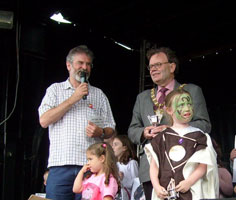7 August 2008 Edition
Celebration and remembrance at Féile

Gerry Adams and Tom Hartley with young Celts at the opening day of Féile
BY JIM GIBNEY
THE 27th anniversary of the death on hunger strike of Kieran Doherty coincided this year with the 20th anniversary of West Belfast’s Féile an Phobail.
Both anniversaries brought back memories of the days when the republican people of this country were locked in a life and death struggle against the British crown forces.
West Belfast Sinn Féin MLA Paul Maskey, speaking at the wreath-laying ceremony for Kieran, captured the essence of the times when he described Kieran Doherty as a fearless republican: fearless on the streets of west Belfast as an active IRA Volunteer; fearless in the prisons when confronted by the brutality of Maggie Thatcher’s prison regime as she tried to criminalise the republican struggle; fearless in the face of death on hunger strike.
This year’s wreath-laying ceremony was particularly poignant because it was the first time in 27 years that Kieran’s father, Alfie, was absent. He passed away earlier this year.
For most of the last 27 years, Alfie and Margaret attended and spoke at Hunger Strike commemorations across this country. The distance involved or the size of the event seemed not to matter to the Dohertys. They turned out to honour their son’s memory and that of the other Hunger Strikers.
They drew great strength from the fact that people, many not born during the Hunger Strike, organised events to pay tribute to the Hunger Strikers.
Watching Féile’s carnival parade last Sunday pass along the Falls Road on its special 20th birthday reminded me of the origins of the first parade in August 1988.
IMPRESSIVE
Last Sunday’s parade was an impressive and colourful pageant of the artistic talent of the people of west Belfast made possible by the voluntary efforts of hundreds of people.
Twenty years ago, many of the same people were being demonised by the political and media establishment and August was a month when anti-internment demonstrations saw death and injury, especially of young people at the hands of the British crown forces and nationalist areas resembled battle zones.
The MP for the area, Gerry Adams, helped to change all of that with his idea of a Féile in August.
And this year’s Féile programme reflects the maturity of 20 years’ experience: family, children and outdoor events were mixed with political debate, literature, drama, films, drive-in movies, exhibitions, tours and walks.
The importance and significance of the Civil Rights movements in the Six Counties and the United States was a prominent theme and backdrop for many of the other debates.
The national and international songs which inspired tens of millions of people to demonstrate against the war in Vietnam, racism in the US and discrimination in the Six Counties were sung with the same gusto and fervour in St Gall’s GAA Club as they were 40 years ago on the streets of Belfast, Washington, Paris and London.
Some of those singing, like Fearghus O’Hare, were leaders of the North’s Civil Rights movement.
USA & IRELAND
Tom Hayden was a leading figure in the anti-Vietnam War and Civil Rights movement in the US in the mid-1960s.
He spoke about the importance of the Civil Rights movement and the victories they achieved in a short period of time which brought far-reaching political change to the US.
The US troops were forced to withdraw from Vietnam; two US presidents were ejected from office; 18-year-olds were given the right to vote, as were 20 million African-Americans; racial segregation was officially ended; and radical books were available for students to read.
The price paid for such change was heavy: John and Robert Kennedy were assassinated, as were Malcom X and Martin Luther King; hundreds of members of the Black Panther movement were also killed in shoot-outs with the police.
A high price was extracted from those demanding their civil rights in both the US and the North of Ireland.
Killing those demanding their civil rights was not just left to those in the state’s forces; loyalists played their part also.
And the Pat Finucane Centre revealed the mentality inside the hierarchy of the British crown forces which made these killings easy.
In a debate entitled Raiders of the Lost Archives they displayed numerous official memos written between 1970-77 which they culled from documents released by the British Government.
Even though we know that collusion between the crown forces and loyalists was endemic, to see it written down in the form of minutes or correspondence between senior members of the British military, British Government ministers and civil servants is still shocking.
POLITICAL PRISONERS
Another first for Féile was the showing of the documentary, Sunday at Five, which examined the lives of two political prisoners, senior republican Séanna Walsh and a UDA loyalist, Billy McQuiston, since their release under the Good Friday Agreement.
The documentary examined their political views, tracing their lives from a young age when they joined their respective organisations, imprisonment, rearing a family through their partners while they were behind bars.
The documentary represented the complexity of the conflict, the changing nature of it as it passed through its many phases, and the impact this had on the two former political prisoners.
It is an excellent example of oral history. Whether you agree or not with the views expressed in the documentary, it is a valuable contribution to understanding why the conflict took place.
And that is also why Féile is important. It provides an opportunity for people to take time out and examine many aspects of life.
Ar an lá breithe speisialta Féile lá breithe shona duit. And many of them.

